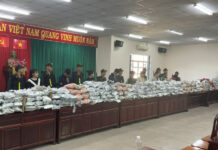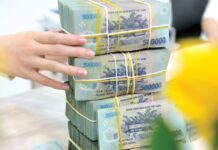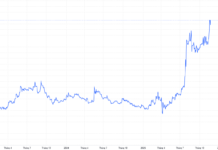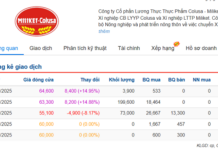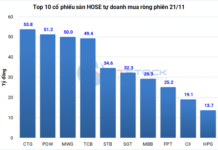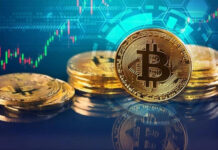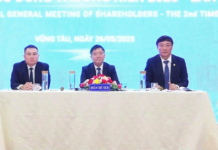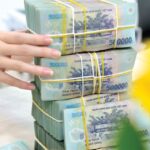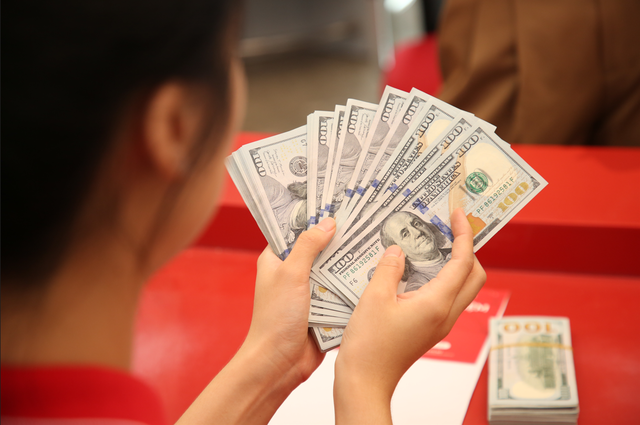
As of midday on April 22, the price of USD in the informal market had surged to around 25,900 VND, approximately 100 VND higher than the previous day. At currency exchange points, the buying price was between 25,780-25,800 VND, while the selling price reached 25,870-25,900 VND.
The price of USD at banks remained at the ceiling price with the selling price at 25,485 VND.
————————
On the morning of April 22, the State Bank of Vietnam (SBV) announced the central exchange rate at 24,272 VND, an increase of 12 VND compared to the end of the previous week. With a fluctuation band of +/- 5%, the floor and ceiling exchange rates applied to commercial banks today are 23,059-25,485 VND/USD. The selling price of USD was kept unchanged by the State Bank of Vietnam’s Foreign Exchange Reserve Management Department at 25,450 VND.
Similar to the sessions at the end of the previous week, USD prices at banks increased sharply to the maximum allowable level as soon as the market opened this week. The selling price of USD was listed at the ceiling of 25,485 VND.
Specifically, the price of USD at Vietcombank is currently listed at 25,175-25,485 VND, an increase of 12 VND compared to the end of the previous week. BIDV and VietinBank listed prices at 25,185-25,485 VND and 25,160-25,485 VND, respectively.
Private banks also raised their exchange rates significantly. Currently, Techcombank is applying 25,240-25,485 VND, while ACB has listed 25,240-25,485 VND.
Last week, the USD exchange rate at banks also increased by 293 VND. Since the beginning of the year, the bank’s USD price has increased by around 1,065 VND, equivalent to a 4.5% increase.
The USD price in the informal market has also been rising rapidly in recent days. Currently, the buying price at many currency exchange points in the unofficial market has reached 25,780 VND, while the selling price has also risen to around 25,850-25,880 VND. Accordingly, within a week, the USD price in the informal market has increased by about 350 VND in both buying and selling directions.
In the international market, the DXY index, which measures the strength of the US dollar against major currencies, remained at its highest level in the past six months, above 106 points.
At a press briefing on the results of banking operations in the first quarter of 2024 on April 19, Deputy Governor Dao Minh Tu said that since the beginning of the year, the VND has depreciated by about 4.9% against the USD. However, this depreciation is still much lower than that of other currencies in the region and around the world. According to Mr. Tu, there are three main reasons for the increase in exchange rates.
Firstly, expectations that the US Federal Reserve (Fed) will cut interest rates at a high frequency in 2024 have not yet materialized. This has significantly impacted the exchange rates of various countries, including Vietnam.
Secondly, the complex global economic situation, geopolitical tensions, rising gold and oil prices, etc., are also factors affecting the exchange rates of countries in general, especially those with a high degree of openness like Vietnam.
Thirdly, Vietnam’s interest rate policy goes against many countries in the world when other countries raise interest rates, the SBV adjusts interest rates down to support economic growth. The low interest rate policy has somewhat impacted exchange rates, especially in the interbank market, by creating a negative interest rate differential between VND and USD.
On the morning of April 19, the SBV also announced that it had taken stronger measures to stabilize the foreign exchange market by selling foreign exchange interventions to commercial banks with negative foreign exchange status to bring their foreign exchange status to 0, with the selling intervention rate at 25,450 VND. According to the SBV’s leadership, this is a very strong measure taken by the SBV to ensure that market sentiment is eased, market supply is ensured, foreign exchange supply is uninterrupted, and legitimate foreign exchange demand of the economy is fully met.
Despite the SBV’s move to sell foreign exchange, the USD price at banks and the free USD price have both continued to rise sharply.




